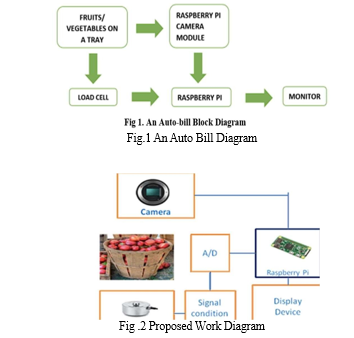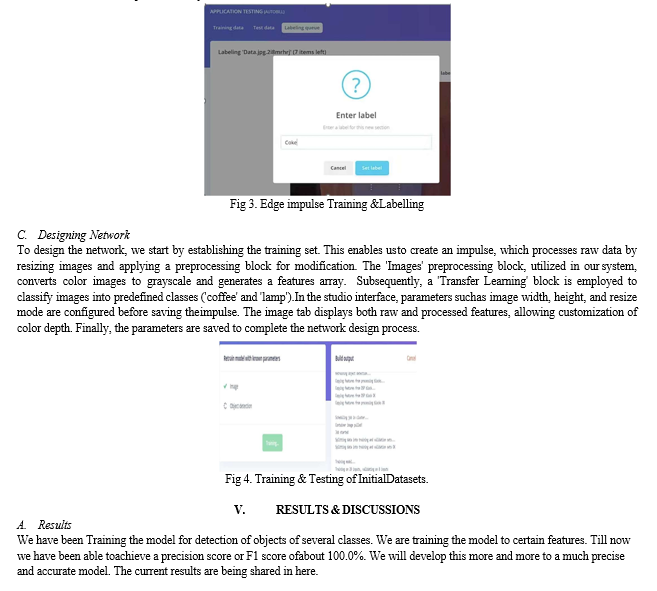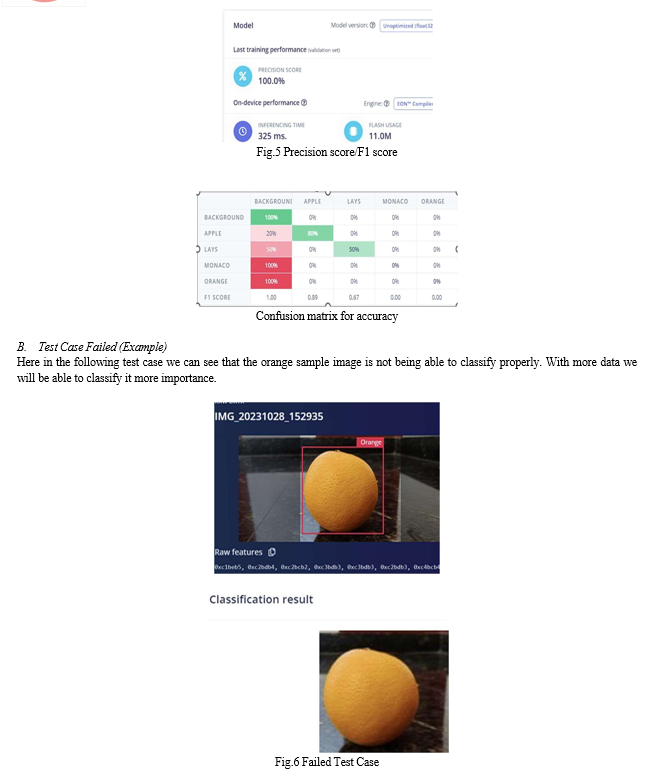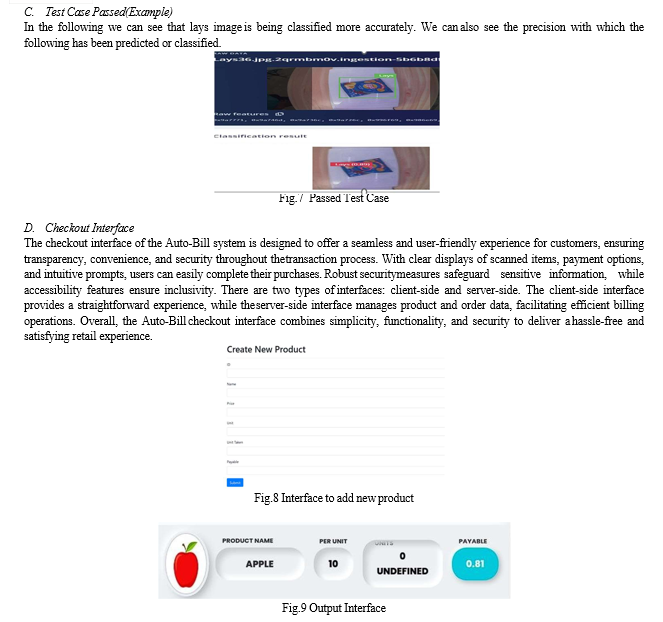Ijraset Journal For Research in Applied Science and Engineering Technology
- Home / Ijraset
- On This Page
- Abstract
- Introduction
- Conclusion
- References
- Copyright
AI-Powered Autonomous Checkout System for Retail Stores
Authors: Kishen Vivel Mascarenhas, Nihal C, Nagarjuna T, Manoj Kumar, Yashpal Gupta
DOI Link: https://doi.org/10.22214/ijraset.2024.62209
Certificate: View Certificate
Abstract
Auto Bill offers a smart, automated checkout service for shops, leveraging state-of-the-art machine learning and computer vision technologies to provide an exceptional shopping experience. Designed to minimize interactions for security purposes during the pandemic, the innovation lies in utilizing modern techniques like image processing and weight sensors to create a novel shopping experience. This system aims to surpass traditional weight scales by incorporating advanced image recognition technologies, benefiting customers with a highly user-friendly interface, reduced checkout times, and improved accessibility. With a multifaceted approach involving deep learning neural networks and a web-based interface for transactions and inventory monitoring, Auto Bill envisions a future where retail checkout is taken to new heights. Supermarkets adopting this system can enhance customer service through its advanced machine learning and camera technology, offering a seamless shopping experience. By integrating easily with existing POS systems, this solution streamlines operations and improves overall efficiency in the retail industry. With continuous testing and adjustments, Auto Bill aims to refine retail checkout to unprecedented levels of accuracy and customer satisfaction.
Introduction
I. INTRODUCTION
A. Synopsis
In today's rapidly evolving retail landscape, technological advancements are reshaping the way consumers interact with businesses. One notable innovation at the forefront of this transformation is the emergence of automated checkout systems. Among these, Auto Bill stands out as a pioneering solution, offering a smart and seamless checkout experience powered by cutting-edge machine learning and computer vision technologies.
Auto Bill's mission is to revolutionize the traditional checkout process by addressing key challenges such as long waiting times, manual scanning errors, and the need for extensive manpower. By harnessing sophisticated AI technologies like computer vision and machine learning, Auto Bill streamlines the checkout experience for customers, making it intuitive and hassle- free. Through the integration of image processing techniques and weight sensors, the system automatically identifies and weighs items, significantly reducing checkout times and enhancing operational efficiency.
Moreover, Auto Bill's touch-free and immediate checkout capability is particularly pertinent in the current pandemic context, where minimizing physical interactions is essential for ensuring the safety and well-being of both customers and staff. By prioritizing security and convenience, Auto Bill sets a new standard for modern retail checkout systems.
This research paper delves into the intricacies of the Auto Bill system, exploring its design, implementation methodology, and potential implications for the retail industry. Through a comprehensive analysis of its multifaceted approach, we aim to contribute to the ongoing discourse on the future of retail checkout systems and the transformative impact of automation on customer satisfaction and operational efficiency.
B. Literature Survey
- Y. Sakai, T. Oda, M. Ikeda and L. Barolli, "A Vegetable Category Recognition System Using Deep Neural Network” The study explores the use of deep learning methods to accurately identify and classify various vegetables. Contributing to the development of modern farming technologies. This focuses on the category recognition of vegetables enabling insight into picture interpretation as well as illustrating why DNN is useful in the interpretation of pictorial data. The study acknowledges the distinct challenges that different types of vegetation pose and image classification that we can deploy in our design.
- N. Ragesh, B. Giridhar, D. Lingeshwaran, P. Siddharth and K. P. Peeyush, "Deep Learning based Automated Billing Cart”There has been considerable interest in recent years in the technology of automated payment systems. Various studies explore the integration of technologies such as RFID, computer vision, and machine learning to simplify and improve payment processing. The intersection of deep learning and retail technology has gained attention due to its potential to transform industries for various aspects of the. By providing automated billing cart relies on deep learning, literature searches can move further towards analyses focused on computer vision and object recognition The system helps us to consume deep learning applications in retail, computer vision for product recognition, AI integration in shopping carts, and aspects of human-computer interaction in retail environments.
- M. Sugadev, K. Sucharitha, I. R. Sheeba and B. Velan, "Computer vision based automated billing system for fruit stores," This paper focuses on the application of computer vision in conventional payment systems, especially for fruit shops. An extensive literature on automated payment systems is available at retail provides insights into technological processes. This includes RFID-based systems, barcode scanners, and more recently, computer vision. Research demonstrates the way advanced neural networks could be adapted for successful image classification and entity detection by means of computer-assisted vision. It helps us to learn concepts involved such as DNN’sengagement includes .This includes research into image-processing techniques, machine learning models, and deep learning algorithms optimized for fruit variety identification and classification accuracy, and in automated systems in which users acknowledge and use.
- Image Processing Based Billing System with Edge Computing Image Processing Based Billing System with Edge Computing When we study this paper on image processing in payment systems is examined, we find advances in both optical character recognition (OCR), object recognition, and visual information extraction. Load cells are being used in measuring of weight of an entity. This covers imaging in payment systems, OCR techniques for document scanning, edge computing for payment systems, edge-based imaging, security and privacy in edge computing, and real- time decision making. It also helps explore the broader architectural context.
- J. Haritha, K. Prakash, B. Navina and S. Saveetha, "A Novel Method of Billing System Using Deep Learning" This paper focuses on the application of computer vision in automating billing processes specifically tailored for fruit stores. Articles in this area may include topics on secure payment processing, fraud detection, and improving overall financial performance. home may include blockchain-based payment studies, the integration of IoT (Internet of Things), or other emerging technologies in the area of financial transactions.. to on computer vision applications in retail spans many areas, including product identification, inventory management and consumer acceptance of such methods., new billing systems, and user experience and trust in automated billing.
- DeepWeight: A Semi-Autonomous Food Weight Billing System using Deep LearningGiven the emphasis on food weight measurement, a literature survey can delve into studies that leverage computer vision techniques for weight estimation. It employs a unique approach of using weight cell readings to evaluate the system. It helps us to understand the concepts involved in using Raspberry Pi 3B and also using Machine learning models such as K means Clustering and SVM. We can employ this in our approach that helps us to build an autonomous billing system.
C. Issues In Currently Existing System
Traditional retail checkout processes often result in long wait times, causing frustration for customers and inefficiencies for store operations . The checkout process leads to long wait times, errors in item scanning, and customer dissatisfaction. There is a pressing need for an AI- powered autonomous checkout system to streamline transactions, enhance customer experiences, and optimize store operations.
II. PROPOSED METHOD
The proposed system aims to revolutionize the billing process in grocery stores by automating it through the integration of various technologies. The system utilizes combination of hardware components including a load cell for weighing groceries, a camera for capturing images, and a Raspberry Pi 3B+ microcontroller unit. Deep learning algorithms, facilitated by platforms like Edge Impulse, are employed for image analysis and object classification, with techniques like YOLO enhancing detection accuracy. Additionally, machine learning algorithms such as K-Means and SVM are integrated to refine the classification process. The system computes the total cost for each item based on its weight and type, generating an accurate bill automatically. The Raspberry Pi board, equipped with the necessary algorithms, handles this computation, while a display connected via USB presents the bill to the user.
The front end of the application is developed using HTML and JavaScript, while the back end utilizes Node.js and Express.js. Overall, the proposed system offers a seamless and efficient solution for billing in grocery stores, significantly reducing time and effort compared to traditional methods.

III. SYSTEM DESCRIPTION
A. Hardware Requirements
- Raspberry Pi 3B+: The computational core of the system, Raspberry Pi 3B+ handles image processing, object recognition, and billing calculations, ensuring seamless automation in grocery stores.
- Load Cell: Essential for accurate weight measurement, the load cell detects the weight of items placed on the tray, providing precise billing based on weight.
- Camera Module (Raspberry Pi 5 MP Camera): Captures high-resolution images of items on the tray, facilitating deep learning algorithms to recognize and classify objects accurately for billing purposes.
- Load Cell Amplifier (HX711): Amplifies the signal from the load cell, ensuring precise weight measurements are obtained, which are then used in conjunction with image data for accurate billing calculations in the system.
B. Software Requirements
- Edge Impulse: Empowers the project by enabling the development of machine learning models for object recognition and classification, crucial for automating billing processes in grocery stores.
- Microsoft Visual Studio Code: Facilitates the coding and debugging of software components, ensuring efficient development and integration of algorithms for image processing and data analysis in the project.
- Raspberry Pi Raspbian OS: Serves as the operating system for the Raspberry Pi 3B+, providing a stable and reliable platform for running the automation system, including capturing images, processing data, and generating billing information in grocery stores.
IV. METHODOLOGY
A. Dataset Collection
We are using different sets of datasets for the development of the model. We use predominantly used dataset such as Fruit360. Since We have to customize our datasets for several things and filter out the data we need to use, hence we have to do it manually. All though it is a bit of a tedious process, but it is of significant importance.
We also use manual datasets, like using the datasets from our devices itself. For uploading, just moves on to the Data acquisition tab and just choose a file. Then label it and upload it to the training section. The Edge Impulse will only accept either JPG or PNG image files. Since we are training initially, we have training initially, we have uploaded about 100s of images of objects in four different classes.
B. Data Labelling
The labelling queue displays all the unlabelled information contained within your dataset. It is a simple task to label objects by drawing a box around them and assigning a label. To streamline this process, we utilize an object tracking algorithm in the background, which helps automate the task. If you have the same object appearing in multiple photos, the algorithm can adjust the boxes accordingly, and you only need to confirm the new placement. Once you have finished adjusting the boxes, click on "Save labels" and continue this process until your entire dataset has been labelled.



Conclusion
In conclusion, our newly developed automated billing system marks a significant advancement in boosting efficiency and accuracy in retail transactions. By integrating cutting edge technologies such as Edge Impulse, computer vision, load cells, HX711 amplifier, and Raspberry Pi 3B+, our system ensures a smooth and dependable billing process. Deep learning algorithms enable precise object recognition, while the load cells accurately measure weights. The processing power of Raspberry Pi further enriches the overall billing experience. Moreover, the user-friendly interface provides real-time transparency, guaranteeing customer satisfaction and trust within the retail environment. In essence, our automated billing system represents a technological advancement in retail, emphasizing precision, efficiency, and a usercentric approach to redefine the customer transaction experience.
References
[1] Y. Sakai, T. Oda, M. Ikeda and L. Barolli, \"A Vegetable Category Recognition System Using Deep Neural Network,\" 2016 10th International Conference on Innovative Mobile and Internet Services in Ubiquitous Computing (IMIS), Fukuoka, Japan, 2016, pp. 189-192, Doi: 10.1109/IMIS.2016.84. [2] N.Ragesh, B. Giridhar, D. Lingeshwaran, P. Siddharth and K. P. Peeyush, \"Deep Learning based Automated Billing Cart,\" 2019 International Conference on Communication and Signal Processing (ICCSP), Chennai, India, 2019, pp. 0779-0782, Doi:10.1109/ICCSP.2019.8697995. [3] M. Sugadev, K. Sucharitha, I. R. Sheeba and B. Velan, \"Computer vision based automated billing system for fruit stores,\" 2020 Third International Conference on Smart Systems and Inventive Technology (ICSSIT), Tirunelveli, India, 2020, pp. 1337-1342, Doi: 10.1109/ICSSIT48917.2020.9214101. [4] A Novel Method of Billing System Using Deep Learning J Haritha1, K Prakash1, B Navina1 and S Saveetha1 IOP Conference Series: Materials Science and Engineering, Volume 1084, First International Conference on Circuits, Signals, Systems and Securities (ICCSSS 2020) 11th-12th December 2020, Tamil Nadu, India DOI 10.1088/1757-899X/1084/1/012035 [5] S. Neha, S. Kumari, I. Raj, D. K. Mishra and A. Singh, \"Image Processing Based Billing System with Edge Computing,\" 2020 IEEE 5th International Conference on Computing Communication and Automation (ICCCA), Greater Noida, India, 2020, pp. 46-50, Doi: 10.1109/ICCCA49541.2020.9250815. [6] Image recognition based billing system for fruit shop using raspberry PI A Vennila et al 2021 IOP Conf. Ser.: Mater. Sci. Eng. 1055 012030 [7] A. Titus, M. U. S, N. Krishnan G and M. Francis, \"Deep Weight: A Semi- Autonomous Food Weight Billing System using Deep Learning,\" 2023 International Conference on Control, Communication and Computing (ICCC), Thiruvananthapuram, India, 2023, pp. 1-6, Doi: 10.1109/ICCC57789.2023.10165428. [8] Kim S., Lee H., Park J. (2022). Smart Lighting Integration for Autonomous Checkout Systems. IEEE International Symposium on Smart Technologies, 75-82. [9] Lee C., Kim D., Park E. (2021). Deep Learning Approaches for Object Detection in Auto Bill Systems. IEEE Transactions on Artificial Intelligence, 10(2), 187-198. [10] Patel S., Gupta R., Kumar N. (2019). Transfer Learning for Improved Image Recognition in Retail Checkout. Conference on Neural Information Processing Systems (NeurIPS) Workshop, 185-192.
Copyright
Copyright © 2024 Kishen Vivel Mascarenhas, Nihal C, Nagarjuna T, Manoj Kumar, Yashpal Gupta. This is an open access article distributed under the Creative Commons Attribution License, which permits unrestricted use, distribution, and reproduction in any medium, provided the original work is properly cited.

Download Paper
Paper Id : IJRASET62209
Publish Date : 2024-05-16
ISSN : 2321-9653
Publisher Name : IJRASET
DOI Link : Click Here
 Submit Paper Online
Submit Paper Online

